Related Research Articles

An echinoderm is any member of the phylum Echinodermata of marine animals. The adults are recognizable by their radial symmetry, and include starfish, sea urchins, sand dollars, and sea cucumbers, as well as the sea lilies or "stone lilies". Adult echinoderms are found on the sea bed at every ocean depth, from the intertidal zone to the abyssal zone. The phylum contains about 7000 living species, making it the second-largest grouping of deuterostomes, after the chordates. Echinoderms are the largest phylum that has no freshwater or terrestrial members.

Crinoids are marine animals that make up the class Crinoidea, one of the classes of the phylum Echinodermata, which also includes the starfish, brittle stars, sea urchins and sea cucumbers. Those crinoids which, in their adult form, are attached to the sea bottom by a stalk are commonly called sea lilies, while the unstalked forms are called feather stars or comatulids, being members of the largest crinoid order, Comatulida.

The Kamchatka Peninsula is a 1,250-kilometre-long (777 mi) peninsula in the Russian Far East, with an area of about 270,000 km2 (104,248 sq mi). The Pacific Ocean and the Sea of Okhotsk make up the peninsula's eastern and western coastlines, respectively. Immediately offshore along the Pacific coast of the peninsula runs the 10,500-metre-deep (34,449 ft) Kuril–Kamchatka Trench.
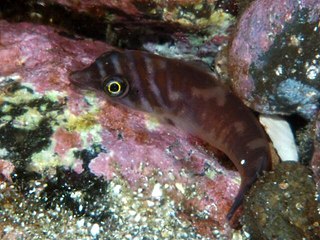
Clingfishes are fishes of the family Gobiesocidae, the only family in the order Gobiesociformes. These fairly small to very small fishes are widespread in tropical and temperate regions, mostly near the coast, but a few species in deeper seas or fresh water. Most species shelter in shallow reefs or seagrass beds, clinging to rocks, algae and seagrass leaves with their sucking disc, a structure on their chest.
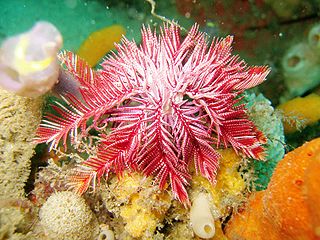
Articulata are the only extant subclass of the class Crinoidea. The group includes "sea lilies" and "feather stars". The Articulata are differentiated from the extinct subclasses by their lack of an anal plate in the adult stage and the presence of an entoneural system.
Kuroshiodaphne phaeacme is a species of sea snail, a marine gastropod mollusk in the family Raphitomidae.

Bathycrinidae is a family of echinoderms in the class Crinoidea. It contains the following genera and species:

Comatulida is an order of crinoids. Members of this order are known as feather stars and mostly do not have a stalk as adults. The oral surface with the mouth is facing upwards and is surrounded by five, often divided rays with feathery pinnules. Comatulids live on the seabed and on reefs in tropical and temperate waters.
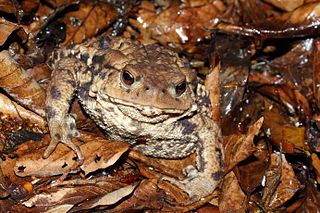
Bufo eichwaldi, commonly known as Eichwald's toad or the Talysh toad, is a species of true toads in the family Bufonidae. It was first described by Litvinchuk, Borkin, Skorinov and Rosanov in 2008 and is found in the Talysh and Elburz Mountains in Azerbaijan and parts of northern Iran. It was previously considered to be a subspecies of the Caucasian toad.

Brookesia thieli, commonly also known as Domergue's leaf chameleon or Thiel's pygmy chameleon, is a species of lizard in the family Chamaeleonidae. The species is endemic to eastern Madagascar, with a type locality of Ambodimanga, Andapa. It was first described in 1969 by Édouard-Raoul Brygoo and Charles Antoine Domergue, and it was ranked by the International Union for Conservation of Nature as "least concern". B. thieli is thought to be found over an area of 43,865 km2 (16,936 sq mi) at 875–1,200 m (2,871–3,937 ft) above sea level.

Bourgueticrinida is an order of crinoids that typically live deep in the ocean. Members of this order are attached to the seabed by a slender stalk and are known as sea lilies. While other groups of crinoids flourished during the Permian, bourgueticrinids along with other extant orders did not appear until the Triassic, following a mass extinction event in which nearly all crinoids died out.
Bathycrinus aldrichianus is a species of sea lily, a crinoid in the family Bathycrinidae. It is native to deep water in the North Atlantic Ocean. It was first described by the Scottish marine zoologist Charles Wyville Thomson and named in honour of Pelham Aldrich, a British naval officer and explorer. It is believed to be the crinoid living at the greatest depth.
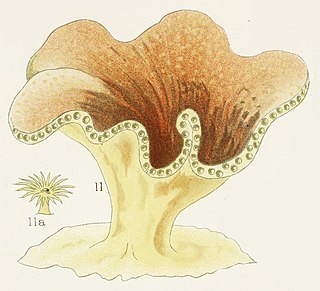
Turbinaria patula, commonly known as disc coral, is a species of colonial stony coral in the family Dendrophylliidae. It is native to the Indo-Pacific region, being found in the eastern Indian Ocean, northern Australia, the South China Sea and the western Pacific Ocean. It is a zooxanthellate coral that houses symbiont dinoflagellates in its tissues. It is an uncommon species and the International Union for Conservation of Nature (IUCN) has rated it as a "vulnerable" species.

Ophiactis savignyi is a species of brittle star in the family Ophiactidae, commonly known as Savigny's brittle star or the little brittle star. It occurs in the tropical and subtropical parts of all the world's oceans and is thought to be the brittle star with the most widespread distribution. It was first described by the German zoologists Johannes Peter Müller and Franz Hermann Troschel in 1842. The specific name honours the French zoologist Marie Jules César Savigny.
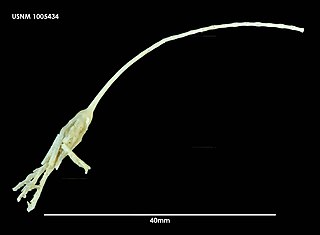
Bathycrinus australis is a species of sea lily, a crinoid in the family Bathycrinidae. It is native to deep water in the Antarctic Ocean. It was initially identified as Bathycrinus aldrichianus by Philip Herbert Carpenter following the 1872-1876 HMS Challenger expedition. It was later distinguished as a new species by the American zoologist Austin Hobart Clark.
Bathycrinus carpenterii is a species of sea lily, a crinoid in the family Bathycrinidae. It is native to the North Atlantic. It was described by Danielssen & Koren.

Bathycrinus gracilis is a species of sea lily, a crinoid in the family Bathycrinidae. It is native to the North Atlantic. It was described by Charles Wyville Thomson.
Bathycrinus mendeleevi is a species of sea lily, a crinoid in the family Bathycrinidae. It is native to the Pacific Ocean west of South America. It was described by A. N. Mironov.

The ninja lanternshark is a lanternshark of the family Etmopteridae found in the eastern Pacific Ocean from Nicaragua, south to Panama and Costa Rica. The depth range of collections is from 836 to 1443 m along the continental slope. E. benchleyi is the only Etmopterus species presently known from the Pacific Coast of Central America.
References
- 1 2 3 Messing, Charles (2015). "Discolocrinus thieli Mironov, 2008". WoRMS. World Register of Marine Species . Retrieved 2015-10-15.
- 1 2 3 Mironov, A.N. (2008). "Stalked crinoids of the family Bathycrinidae (Echinodermata) from the eastern Pacific". Invertebrate Zoology. 5 (2): 133–153.